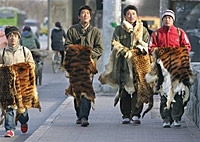




A group of Tibetans in the remote northwestern Chinese province of Qinghai has launched a campaign to destroy traditional costumes made with the skin of endangered species, following an appeal by their exiled spiritual leader, the Dalai Lama.
The residents of Rebkong county, Malho prefecture, had begun burning tiger, leopard, and sea otter skins publicly against the wishes of Chinese authorities after the Dalai Lama called on Tibetans to protect endangered species in January.
“It was started by a young Tibetan named Tseten Gyal. The skins were of tiger, leopard, and sea otter,” a source in the region told RFA’s Tibetan service.
The young man, Tseten Gyal, of Sakyil village in Rebkong, began collecting traditional clothing made with the skins Feb. 8, calling for their destruction by burning.
“Soon after national security officials and local public security officials confronted him and demonstrated their dislike,” the source said. “That very night he was taken to the public security bureau office and interrogated for a long time.”
A witness to the burning confirmed that account.
It was started by a young Tibetan named Tseten Gyal. The skins were of tiger, leopard, and sea otter.
"On Feb. 7, a group of Tibetans burnt animal skins for the protection of the environment and of endangered wild animals. Those included the skins of tigers, leopard, fox, and otter,” the person said.
“I saw that there were a few hundred Tibetans who were either participating in the burning of animal skins, or watching them being burnt. There were perhaps about 500 to 600 people gathered.”
The authorities repeatedly asked if Tseten Gyal had any political motives for his campaign, one source said.
“He insisted that he had no other intention except to protect the natural environment. The security officials forbade him to burn the costumes in skins in public places.”
“They suggested that if his motivation was the protection of animals and the environment, he should destroy the skins in his own home, and not in public,” the source said.
Angry at these restrictions, Tseten Gyal brought all the skins and costumes onto the main road in Sakyil village and set them on fire.
He was joined by other Tibetans, including a man named Gonpo Gyal, who added more skins to the blaze, said the source. The incident was also reported in Chinese on the Amdo-based Tibetan Youth Web site.
A caller from the Amdo region said the action was spontaneous, without a single organizer.
“Some Tibetans vowed in writing that they will never again use animal skins for clothes. All these activities came from personal initiative and voluntary participation,” the caller said, adding that awareness of endangered species and the need to protect the environment was growing among Tibetans.
The action in Rebkong county soon spread to neighboring areas. “Even in Tuo (Daofu) and Gartha in Ganzi prefecture, Tibetans started giving up their costumes made of animal skins and started burning them,” the source said.
The Dalai Lama appealed to Tibetans inside China during his traditional Kalachakra teachings in Amaravati, northern India, in January to protect endangered animals in Tibet and stop using animal skin on their costumes.
His teachings were heard by many exiles from the Amdo-speaking areas of Qinghai, and many more Tibetans heard the appeal via Tibetan radio broadcasts from overseas.
Original reporting in Amdo by RFA’s Tibetan service. RFA Tibetan service director: Jigme Ngapo. Translated by Karma Dorjee and written by Luisetta Mudie. Edited by Sarah Jackson-Han.